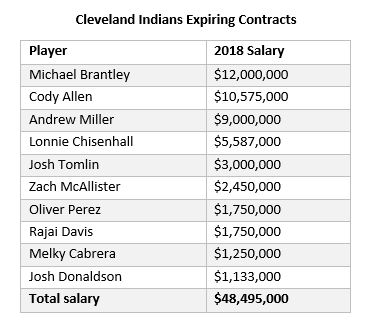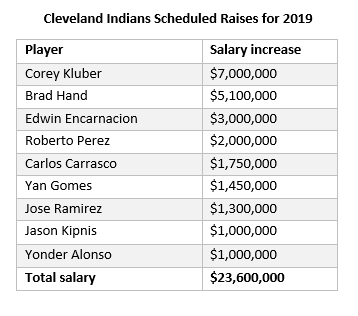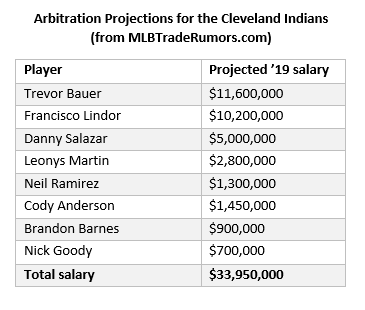For a moment, remember the Cleveland Indians entering the 2017 season:
They had just come within a single run of winning the World Series, despite an injury-depleted roster. They had two of baseball’s bright young stars in Jose Ramirez and Francisco Lindor. Corey Kluber was arguably the game’s best starting pitcher, and Andrew Miller was arguably the game’s best reliever. Jason Kipnis was one of baseball’s best second basemen. All were controlled for at least two additional seasons for pennies relative to what they would make on the free agent market.
Michael Brantley and Carlos Carrasco were the main victims to injury in 2016, but they were set to return in 2017. Cody Allen was a Top-10 reliever in the game, yet still played second fiddle to Miller.
Carlos Santana and Bryan Shaw both were entering their contract years as two of baseball’s most underrated players (and in Cleveland, most under-appreciated).
Cleveland was losing 2016 folk-hero Mike Napoli, but spent $60 million to replace him with one of baseball’s most feared hitters, Edwin Encarnacion. As if the bullpen needed more help, the team went out and got Boone Logan for $5.5 million, who was coming off a career-year in Colorado.
Meanwhile, one of the few holes on the roster was center field, but consensus Top-50 prospect Bradley Zimmer appeared primed to claim the spot.
In short, things looked good. Really good.
Now, two seasons later, the Indians don’t have much to show for it.
A lot went right during the 2017 regular season – most notably a 22-game win streak, a 102-60 record, and a second Cy Young for Corey Kluber. But, some cracks began to show:
- Boone Logan only pitched 21 innings (with a 4.71 ERA) before injuring his left shoulder, ending his season. Including his $1 million buyout for a $7 million option in 2018, the Indians essentially wasted $6.5 million on Logan.
- After Logan went down, Cleveland acquired Joe Smith from the Blue Jays in exchange for Thomas Pannone, who was arguably Cleveland’s #2 pitching prospect at the time. Smith pitched 20.2 total innings for Cleveland in 2017 before leaving in free agency. In 2018, Pannone made 6 starts for Toronto, going 4-1 with a 4.19 ERA.
- Jason Kipnis and Michael Brantley dealt with injuries and ineffectiveness, missing a combined 144 games.
Of course, Cleveland lost the ALDS to the Yankees in 5 games, and were left to regroup during the 2017 offseason. Along with Smith, Bryan Shaw and Carlos Santana left the organization in free agency.
After aggressively signing Encarnacion and Logan following the 2016 season, Cleveland looked incredibly timid in the aftermath of their ALDS defeat.
- In Santana’s place, the team signed Yonder Alonso to a 2 year/$16 million deal.
- They didn’t acquire any replacements for Smith or Shaw.
- In an offseason where Giancarlo Stanton, Christian Yelich, Marcell Ozuna, Andrew McCutchen, Randall Grichuk, Corey Dickerson, and Stephen Piscotty were traded, the Indians failed to improve their outfield.
So, the team limped into 2018 with major question marks in the bullpen, in the outfield, and at second base. It seemed the only sure things on the roster were the starting pitchers, Francisco Lindor, and Jose Ramirez.
Playing in a downtrodden AL Central, Cleveland didn’t need much more than that to secure a third-straight division title. Despite a winning record, many things continued to go wrong the Indians.
- Kipnis – owed $30.5 million between 2018 and 2019 – was one of baseball’s worst hitters over the first 45 days of the season. Though he slashed .255/.349/.446 in the final 108 games of the season, his overall numbers remained lackluster at best.
- Alonso – fresh off his 2 year/$16 million contract with Cleveland – posted a below-average .250/.317/.421 slash line in 2018.
- After opting against replacing Shaw or Smith over the offseason, Cleveland’s bullpen was one of baseball’s worst, finishing the season with a 4.60 ERA.
- They tried to improve the bullpen midseason by trading prized catching prospect Francisco Mejia to San Diego for Brad Hand and Adam Cimber. Hand was excellent, but Cimber was terrible (4.05 ERA, 7 K, 7 BB in 20 innings).
- Bradley Zimmer – Cleveland’s heir-apparent in center field – batted .226/.281/.330 in 34 games before being sent down to AAA Columbus, where he played 6 games before tearing his labrum. Zimmer is likely to miss at least half of the 2019 season.
- Lonnie Chisenhall was expected to play nearly every day in right field, but played in only 29 games before missing the rest of the season due to a calf injury.
- After largely living up to the expectations of his contract in 2017, Edwin Encarnacion’s age appeared to finally catch up to him. He had easily his worst season since 2011, and watched his OBP drop 41 points from his 2017 mark. Encarnacion is owed $20 million next season, with a $5 million buyout for 2020 that is all but guaranteed to be exercised.
- To improve the outfield, the Indians acquired Leonys Martin from Detroit in exchange for shortstop prospect Willi Castro, the 10th-best prospect moved at the trade deadline according to FanGraphs. Martin played in 6 games for Cleveland before contracting a life-threatening bacterial infection that ended his season. His status for next season is unclear. The same day that Cleveland traded for Martin, the Rays acquired outfielder Tommy Pham (and international bonus pool money) from St. Louis in exchange for three prospects, ranked the #12, #48, and #59 prospects traded at the deadine by FanGraphs.Pham went on to hit .343/.448/.622 in 39 games for Tampa Bay.
- Andrew Miller and Cody Allen – arguably the best 1-2 bullpen punch in baseball in 2016 – were shells on their former selves. Miller struggled with knee and shoulder problems all year, and pitched in just 37 games, posting a 4.24 ERA.Allen appeared healthy, but averaged just 94 mph on his fastball for the season, which was a career-worst. The results (4.70 ERA) followed suit.
Some things did go right: the starting pitching was excellent as expected. Francisco Lindor and Jose Ramirez put up MVP numbers. Michael Brantley returned to his All-Star form. Yan Gomes was even named an All-Star, and enjoyed his best season since 2014. But it wasn’t enough to even approach the team’s goal of winning a World Series. Cleveland finished the regular season with the worst record of any American League playoff team, and was promptly swept in the ALDS by Houston.
Now, the Indians enter the 2018-19 offseason at something of a crossroads. They have over $48 million coming off the books from their expiring contracts.
Additionally, they could (but probably shouldn’t) decline Brandon Guyer’s $3 million option for 2019. This would bring them to a total of about $51.5 million to work with before scheduled raises and arbitration are factored in.
If the Indians offered contracts to all of their players entering arbitration, they would begin 2019 with $9.1 million in additional salary, before any other offseason additions. If you count the $1 million owed to Chris Johnson in 2018, that figure drops to $8.1.
Now, Salazar, Goody, and Martin are all currently dealing with health issues, meaning it’s plausible Cleveland could non-tender any or all of them. Cleveland also doesn’t have a need for Barnes. So, their arbitration obligations could be worth around $10 million less.
Regardless, the overarching theme is that Cleveland will either need to raise their payroll (a year after recording the highest payroll in team history), or get creative and dump Jason Kipnis (owed 14.5 million in 2019) and/or Yonder Alonso (owed $8 million in 2019).
At a time where the team’s payroll is maxed out, Cleveland’s farm system is also probably as weak as it’s been in 5 years. The organization probably only has one “premier” prospect in Triston McKenzie, and only a few other prospects of value in AA or above (Yu Chang & Oscar Mercado).
Frankly, Cleveland needs to get out a hole they put themselves in. Alonso’s contract was objectively a mistake. Encarnacion’s signing was an aggressive risk that appears to have done more harm than good. Trading for Martin instead of Pham (and passing on acquiring players like Yelich, Pham, or Cain) was also clearly a misstep.
The future isn’t as bright as it was when the 2017 season began. Chris Antonetti and Mike Chernoff have their work cut out for them if they want the team to remain a World Series contender in the coming seasons.
Add The Sports Daily to your Google News Feed!


